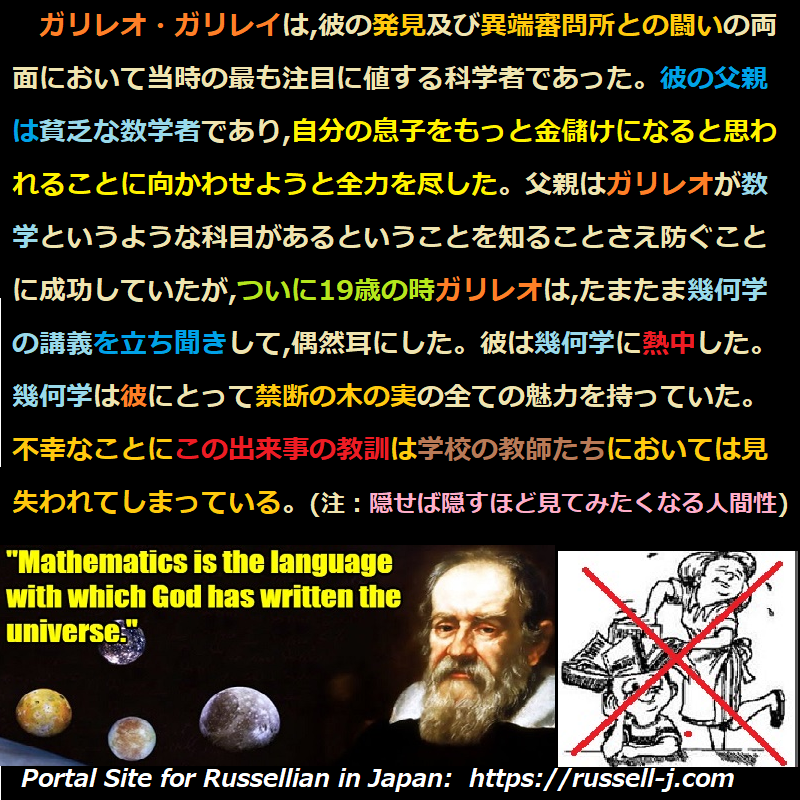
ガリレオ・ガリレイ(1564-1642)は,彼の発見(発見した事柄)及び異端審問所との闘いの両面において,当時の最も注目に値する科学者であった。彼の父親は貧乏な数学者であり,自分の息子を(数学よりも)もっと金儲けになると思われることに向かわせようと全力を尽した。父親は,ガリレオが数学というような科目があるということを知ることさえ防ぐことに成功していたが、ついに19歳の時,ガリレオは,たまたま,幾何学の講義を,立ち聞き者の一人として(as an eavesdropper),偶然耳にした。彼は幾何学に熱中した(He seized with avidity upon the subject. 幾何学を貪欲に捕まえた)。幾何学は彼にとって禁断の木の実の全ての魅力を持っていた。不幸なことに,この出来事の教訓は学校の教師たちにおいては見失われてしまっている。(注:隠せば隠すほど見てみたくなるという人間性) ガリレオの大きな長所(取り柄)は,実験技術/技能及び機械操作の技術/技能と,実験結果を数学的公式に具体的に表わす能力とを,結びつけることであった(荒地出版社刊の津田訳では「The great merit of Galileo 」を「ガリレオの偉大な功績」と訳出している。「功績」という意味を持つのは,通常複数形「merits」)。力学,即ち,物体の運動を支配する法則の研究は,事実上(virtually 実際上),彼と共に始まっている。古代ギリシア人は静力学(注:statics / statistics と混同しない),即ち平衡の法則を研究した(注:平衡には熱平衡や力学的平衡などがあるが、ガリレオの場合は力学的平衡/慣性の法則を思い浮かべるとよい)。しかし,運動の法則,特に加速度(変化する速度)を持つ運動の法則は,古代ギリシア人によっても,また,16世紀の人々によっても,完全に誤解されていた。まず,運動している物体はそのまま放っておくと(何も力が加わらなければ)止まってしまうだろうと考えられていたがしかるに(一方),ガリレオはもし外部から影響(力)を全く受けなければ真っ直ぐに等速度で動き続けることを立証した。言い方を変えると(To put the matter in another way),(その物体の)周囲の状況が,物体の運動に対してではなく - 方向においてであれ,速度においてであれ,あるいはその両者であれ- 運動の変化に対して,説明のために探求されなければならない(must be sought for)(注:加速度と方向のベクトル運動のこと)(To put the matter in another way 「言い方を変えると」を津田氏は「その状態を変えるには」と訳出しており,慣用句だと気づかなかった模様。)。運動の速度,あるいは,(運動の)方向における変化は,「加速度」(acceleration)と呼ばれる。このように,なぜは物体がそのように動くかを説明する際,力が(その物体の)外部から働いたことを示すのは加速度であって速度ではない。この原理の発見は,力学(の発展)における不可欠な第一歩であった。
Chapter 2: The Copernican Revolution, n.9
Galileo Galilei (1564-1642) was the most notable scientific figure of his time, both on account of his discoveries and through his conflict with the Inquisition. His father was an impoverished mathematician, and did his utmost to turn the boy towards what he hoped would prove more lucrative studies. He successfully prevented Galileo from even knowing that there was such a subject as mathematics until, at the age of nineteen, he happened, as an eavesdropper, to overhear a lecture on geometry. He seized with avidity upon the subject, which had for him all the charm of forbidden fruit. Unfortunately the moral of this incident has been lost upon schoolmasters. The great merit of Galileo was the combination of experimental and mechanical skill with the power of embodying his results in mathematical formula. The study of dynamics, that is to say, of the laws governing the movements of bodies, virtually begins with him. The Greeks had studied statics, that is, the laws of equilibrium. But the laws of motion, especially of motion with varying velocity, were completely misunderstood both by them and by the men of the sixteenth century. To begin with, it was thought that a body in motion, if left to itself, would stop, whereas Galileo established that it would go on moving in a straight line with uniform velocity if it were free from all external influences. To put the matter in another way, circumstances in the environment must be sought for to account, not for the motion of a body, but for its change of motion, whether in direction or velocity or both. Change in the velocity or direction of motion is called acceleration. Thus in explaining why bodies move as they do, it is acceleration, not velocity, that shows the forces exerted from without. The discovery of this principle was the indispensable first step in dynamics.
出典:Religion and Science, 1935, chapt. 2.
情報源:https://russell-j.com/beginner/RS1935_02-090.HTM
